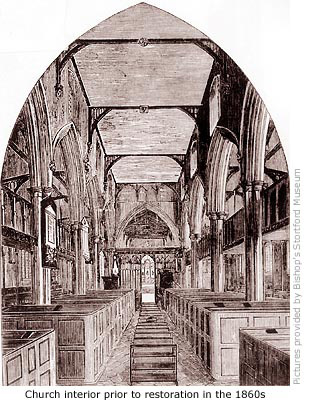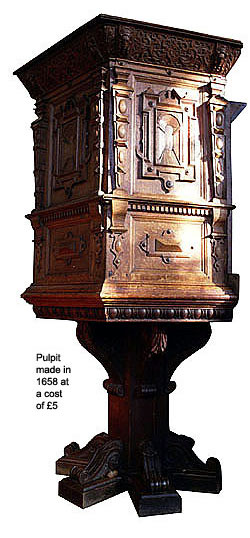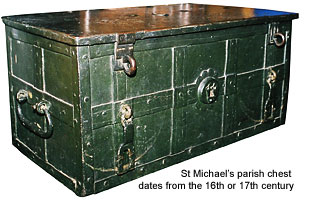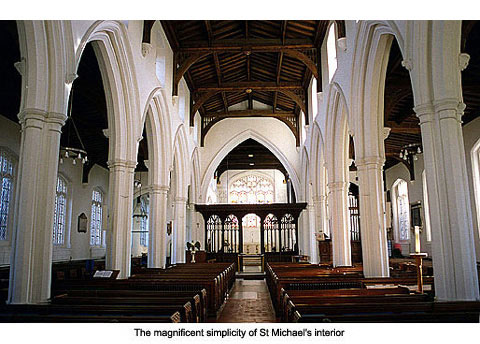|
Such was the popularity of the town’s Grammar school in 1709 that a new gallery had to be erected to accommodate the ever-increasing number of pupils attending Sunday services. But nine years later a form of modernisation took place within the church: the medieval roof beams were covered in by plaster, high box pews were installed, and all exposed woodwork was painted over.
When a taste for Gothic returned in the 19th century, all of these alterations were removed or changed during restoration work in 1867-9, carried out under the direction of diocesan architect, Joseph Clarke. Schoolboys were still able to attend services when the North aisle, now the Lady Chapel, was extended but during one period of work, in 1868, the Corn Exchange in Market Square was temporarily used as the parish church. Also revealed at this time was a medieval font, found under the floor of the church and probably hidden there for protection during the Reformation. Dating from around 1150 it was skilfully reset on a new base, given a new cover and remains in use to this day.
The church's greatest loss is its medieval stained glass, said to have been equal to that of King's College Chapel at Cambridge. At one time virtually every window was vividly coloured with depictions of saints and priests, martyrs and biblical scenes, arms and kings. Most of this glass survived the Reformation but not the political upheaval of later years.
Replacement stained glass windows came in the 19th century. The west window depicting the four Archangels is by Kempe, 1877, a memorial to Rev F.W. Rhodes and his wife. This can be seen from the tower room. The east window, installed in 1885, was a gift from the Precentor of St Paul’s Cathedral, Rev C.A. Belli, and shows events in the Gospels. To make room for this window the original, executed in the painting tradition of the 18th century by Powell in 1853, was moved to become the south chancel window. At the same time the floor of the chancel was raised, the arch re-cut and the roof lifted to accommodate the clerestory. The window in the Lady Chapel by Christopher Webb was given by the widow of a local man, Percy Johnson, in 1928, and one of four small windows in the South porch is by Miss Aldrich Rope.
 The communion table is modern but stands on the ancient altar slab. Italian craftsmen were especially hired in 1885 to add mosaics to the altar – the same craftsmen who carved decorative stonework for the exterior of Speechley and Millbank’s chemist shop in North Street (See Guide 6). Today’s altar, altar cross and surround are the work of S E Dykes Bower, carried out in 1965. (See also Guide 10 – Stansted Road) The communion table is modern but stands on the ancient altar slab. Italian craftsmen were especially hired in 1885 to add mosaics to the altar – the same craftsmen who carved decorative stonework for the exterior of Speechley and Millbank’s chemist shop in North Street (See Guide 6). Today’s altar, altar cross and surround are the work of S E Dykes Bower, carried out in 1965. (See also Guide 10 – Stansted Road)
There are 107 memorials inside the church, ranging from ancient stone floor slabs to more recent small brass plates screwed onto pews and choir stalls. They also include wall tablets, some made of marble, two stone charity tablets in the South porch, and six stained glass windows.
The largest memorial is the 'List of Vicars of Bishop's Stortford': the first, described as A Priest (name unknown) 1086, the last being the current vicar, Toby Marchand, installed 1995. To date, 59 vicars have spanned more than 900 years.
41 memorials in the form of stone slabs are to be found in the North, South and Centre aisles and in the Chancel, many of which are now unreadable due to erosion and natural wear. However, because early historians made a point of recording such things, we do know the content of most inscriptions. Much is also owed to William Blyth Gerish (1865–1921) who, between 1907 and 1913, recorded virtually every church and churchyard monument in Hertfordshire.
But although Gerish's records are unique, what he didn't always do was copy exact wording on all memorials, or make public any personal maps or reference points he may have used to note where inscriptions were located. The probable reason for this was because he knew that memorials would one day be lost to future generations, so only concerned himself with making lists of names and dates and, when found, recording any bonus information regarding relationships and occupations. (See Guide 12 for a short biography of William Blyth Gerish)
In Bishop's Stortford we are doubly fortunate to have had an outstanding local historian by the name of John Laybank Glasscock (1854–1929). A contemporary of Gerish, and with an equal interest in archaeology and genealogy, he made his own lists of St Michael's monument inscriptions, prior to 1881. More importantly, he grouped his lists to show the exact part of the church or churchyard 'plot' in which he found them. Like Gerish, he also didn’t record the precise wording of all inscriptions he found, nor did he find all of the memorials later recorded by Gerish, but he (and others) did discover some that Gerish missed.
Hertfordshire Family History Society (H.F.H.S.), established in 1977, has transcribed all extant memorials in 115 parishes of Hertfordshire in 87 books to date: a task that is certainly indebted to Gerish's manuscripts and the notes of other historians, but owes far more to the skill and dedication of the Society's members. In preperation for each publication, they visit the church and churchyard that is the subject and physically clean and transcribe each and every visible memorial, recording far more information than Gerish, or others, ever did. And with more than 40 county churches and churchyards still to be fully explored, the Society's work is far from over. One of their most recent (2006) publications 'Monumental Inscriptions of The Parish Church of St Michael Bishop's Stortford' includes maps of the church and churchyard, created by the F.H.S. using Glasscock’s detailed lists to show where memorials can still be found.
What makes this publication all the more interesting is that no interments have taken place in St Michael’s church or churchyard for over 150 years. (Also see ‘The Churchyard’ in this Guide)
Inscriptions on more than 30 of the stone slabs here, inform us that the person or persons commemorated had been interred beneath the memorial stone. These mostly date from the 18th and early 19th century. Back in the 16th century, anyone of note (and monied) could be interred within the church for a fee of 6s. 8d (33p), the cost being the same whichever part of the church he or she was interred. The same principal no doubt applied in future centuries, though the cost probably increased.
Names on these floor stones include the Wilby family, former landowners in Stortford, and the wealthy Sandford and the Brome families. As a clue to the latter's ancestry, we learn that 'John Brome, linen draper and citizen of London, died 1783 aged 65, was descended from the very ancient family of whom William de Brome was standard bearer to King Edward III'.
Also with royal connections was Peter Mark Sparke, said to be onetime doctor to Charles I. This isn't revealed on the floor slab or nearby wall tablet, both of which commemorate him in Latin, but a brief translation (by Cussans) tells us that this 'Philosopher and MD, recognised in Germany, Italy, France and Britain, died 24th September 1675 aged 67 years.' He is also supposed to have lived in the town at the corner of South Street and, what is now, Apton Road. There must be an element of truth in this otherwise he may not have been buried here.
One person with a definite link to royalty was Lady Margaret Denny, formally Lady Margaret Edgecumbe, who for five years was a favourite maid of honour to Queen Elizabeth I before marrying Edward Denny in 1583 (See Guide 10). He died in 1599 and was buried at Waltham Abbey, Essex, but Lady Denny lived on a further 49 years, reaching the age of 88. In her will she directed that 'cost be spared and my body be buried in Stortford Chauncell.'
Her memorial, the oldest in the church, reads: ‘The truly honoured Lady Margaret Denny, descended of the ancient family of Edgecumbes of Mount Edgecumbe in Cornwall; a maid of honour in ordinary for five years to Queen Elizabeth of blessed memory then married to Sir Edward Denny Kt., groom of her Majestie’s Privy Chamber, who departed this life April 24, 1648 aged 88 years and in the 48th year of her widowhood.'
When the Chancel had to be extended in the 17th century to accommodate the ever-growing vault of the Denny family, Edward Denny, at that time one of the Secretaries in the Admiralty, paid for the work. The symbols 'ED 1660' can be seen burned into the wood on one of the church beams.
Hatchments were put outside a person’s house when they died and after a period of mourning were then hung in the church. Above the North door, painted on canvas, is the hatchment for Sir George Duckett and above the South door, painted on wood and bearing their coat of arms, is the hatchment of the Denny family. Both have been recently restored.
The most poignant memorial in the church is the Maplesden Monument; a large wall tablet inscribed with the names of seven children from one family. Six of them, aged 5 to 20 years, died of smallpox between 26 October and 3 December 1684, and the seventh child died in June 1685. The inscription further tells us that the youngest daughter died in 1686, aged 4, the father died in 1689, and the mother in 1712.
Smallpox was rife throughout the land in the second half of the 17th century, and no doubt claimed many more townspeople. The disease was certainly arbitrary. Another stone slab records 'Simon Rutland MD of this town, BA Camb., doctor of medicine, who fell victim to smallpox at Brentwood, in the flower of his age, while endeavouring to relieve the distress of others.' He died in 1682.
A large plaque on the north wall commemorates Cecil Rhodes (1853–1902), founder of Rhodesia (now Zimbabwe), and his father, Rev Francis W. Rhodes (1807–1878 is remembered by a stained glass window in the church tower. Sir George Jackson, Bart, afterwards Sir George Duckett (See Guide 11) is also commemorated here. He was a friend and patron of Captain James Cook, who named after him Point Jackson in New Zealand and Point Jackson in Australia (now better known as Sydney). He was also instrumental in making the River Stort navigable, and though he held a house in the town he never lived here. Despite this, his greatest wish was to be buried in St Michael's churchyard and that wish was fulfilled when he died. This wall tablet gives far more information than the epitaph on his churchyard box tomb, which simply reads: 'Sir George Duckett Bart, Died 15th December 1822, Aged 97'.
Many of the above names are instantly recognisable and synonymous with Bishop's Stortford, but the majority of memorials here are anonymous to the town's history. There are, though, three small memorials that pay tribute to 'ordinary' individuals who played their part in world history and made the ultimate sacrifice.
Two of these were young men of Stortford who became soldiers: one, Private Ernest William Boyden, aged 20, killed in 1901 while on active service at Thaba'nchu in the Boar War; the second, Guy Vickery Pinfield, killed in action during the Irish Rebellion, 1916, aged 21. The third, Jack William Stubbings, Sergeant Pilot R.A.F.V.R., lost his life on air operations in 1945.
A World War I wall tablet memorial dedicated by Bishop's Stortford Royal British Legion, commemorates General French's 'Contemptible Little Army' Mons – Marne – Aisne – Ypres. 5th August – 22nd November 1914.
(This refers to the name given to Sir John French's British Expeditionary Force (BEF), by Kaiser Wilhelm II. Irritated by Britain's 'treacherous' decision to go to war against Germany, and of the BEF. he ordered that Sir John's 'contemptible' little army be defeated forthwith. His meaning of the word is still debated as to whether he regarded the BEF to be itself contemptible or was it contemptible simply on account of its small size? British Army regulars from 1914 adopted the description as something of a badge of honour and after the war called themselves 'The Old Contemptibles.')
Not all recorded memorials are now visible. These include J.L. Glasscock's listed memorial inscriptions (1881) that had been recorded in the church by earlier historians, simply by name and date, of which he gave his own explanatory notes.
William Blyth Gerish also noted the following extract annotated (c1890) by W.F. Andrews from John Weever's Ancient Funeral Monuments (1631) in respect of two memorials in the church, now no longer visible:
Thomas Fleming 1436
Joanna Fleming 1411
'A familie whose numerous branches have spread themselves throughout England, Scotland and Wales ever since the time of Sir John le Fleming, knight, who flourished in the reign of King William Rufus.' [Rufus was the second surviving son of William the Conqueror c.1056–1100]
A Thomas Fleming owned property at Bishop's Stortford in 1417, 1421 and 1426.
There are also three interments in the vault of St Michael's not commemorated by any memorial (See Guide 4 – King Harold).
*Memorial inscriptions used in this text were taken from ‘Monumental Inscriptions of The Parish Church of St Michael Bishop's Stortford’, and used by kind permission of Hertfordshire Family History Society. For more information on the Society’s activities and publications, email the Secretary at secretary@hertsfhs.org.uk or visit the Society’s website at www.hertsfhs.org.uk
The Screen at the entrance to the chancel is 15th century, except for the vaulting at the top that was added by Blomfield in 1885. It was the Rood Loft above this screen that was the subject of removal and re-erection during the Reformation period. On the south side of the North aisle, at the east end, is the turret that contained the stairs to the rood loft. Although the stairs have gone, the upper and lower doorways remain.
A local carpenter made the beautifully carved hexagonal oak pulpit in 1658. Furnished with a fold down floor that can be raised up for shorter preachers, it cost just £5 to make but with extras, such as a cushion, the total charge came to £9. 19s. 5d. (£9. 93p).
The earliest mention of an organ in the church is in 1490 when churchwardens paid a 'strange priest or clerk' 8d (4p) for playing it. The current organ, standing in a large chamber on the south side of the chancel, was originally built by Kirkland in 1880 and bought at a cost of over a thousand pounds, raised by subscription. The church had no electricity until an appeal for funds was started in 1933. This in turn led to modernisation of the organ in 1940 with electrical actions added by J S Walker. A thorough overhaul in 1997 entailed restoration of the soundboard on which the two thousand or more pipes stand.
 After the town’s Grammar School and Library was pulled down in 1770, a few ‘select’ residents looked after its collection of 2,000 valuable books in their own houses. And there they remained until 1824 when the school’s Trustees transferred the entire collection to a prepared room in the church tower and made them accessible to townspeople. After the town’s Grammar School and Library was pulled down in 1770, a few ‘select’ residents looked after its collection of 2,000 valuable books in their own houses. And there they remained until 1824 when the school’s Trustees transferred the entire collection to a prepared room in the church tower and made them accessible to townspeople.
Modern day alterations were carried out on the lower part of the tower in 1977, which now accommodates two meeting rooms a kitchen and cloakroom.
The King’s Commissioners sold the original church plate during the reign of Edward VI. The current collection, though not very large, consists of some fine pieces including: a beautiful chalice of silver and guilt made in 1597 by John Frankman, the great Elizabethan goldsmith; a paten dated 1653, and two flagons of 1721 and 1731. All are now kept in the bank and only used on special occasions. MORE PICTURES
|
|
The safe-keeping of valuable metal works and rich fabrics contained within medieval parish churches was generally the responsibility of the incumbent priest and churchwardens. These treasures, along with church records, would sometimes be stored in the house of the priest or in that of one of the wardens, but usually they were kept within the church inside a chest, 'ark', 'coffer', or 'hutch'. Many of these chests were presented by parochial benefactors and most stood by the north wall of the sanctuary. Chantry chests generally stood close to their respective altars.
It's possible that the Saxons and Normans had such chests, albeit somewhat primitive, but they became statutory requirements after Henry II (1154–89) issued a royal mandate ordering chests to be placed in all churches for the use of the faithful. The idea behind this was that they deposit there-in their alms to aid the various crusades the King was embarking upon. Pope Innocent III issued a similar order in the reign of King John (1199–1216).
 The injunction made it obligatory for every church to provide 'a hollow trunk', fastened with three keys, the latter to be kept severally by the bishop, the priest, and a religious layman'. A further order for the provision of chests was issued by the Synod of Exeter in 1287, when they ordained that every church should have a chest to hold books and vestments.
The injunction made it obligatory for every church to provide 'a hollow trunk', fastened with three keys, the latter to be kept severally by the bishop, the priest, and a religious layman'. A further order for the provision of chests was issued by the Synod of Exeter in 1287, when they ordained that every church should have a chest to hold books and vestments.
The Poor Law of 1552 directed that parishoners in every parish should provide a strong chest for holding alms for the poor, the order repeated in Elizabethan legislation and made more definate in the canons of 1603. Later legislation ordered that a separate chest should hold parish registers, although it's likely that one chest was used to serve both purposes.
St Michael's parish chest, made of iron, is known as an 'Armada' chest. It is a type found in many churches in England, and though the name conjures up pictures of shipwrecked Spanish galleons there is, apparently, no connection what-so-ever with the Spanish Armada. The chests, made in Flanders, Germany and Austria during the 16th and 17th centuries, were imported into England in large numbers, their popularity no doubt increased by the fixed rate of duty imposed on their import. Earliest reference to St Michael's chest was in 1538, but it is not known how the church came by it, or what use it was put to. It can only be assumed that it was used to house church valuables and churchwardens' accounts, and for the collection of alms from parishioners.
The chest has a dummy keyhole at the front, but the real keyhole is concealed in the lid where the complicated locking system is housed, its many bolts fastening the lid to all four sides of the chest. Positioned at the west end of the south aisle, the chest was for many years kept open to show the workings of its lock, but is now kept perminently closed for safety reasons.
|



 The communion table is modern but stands on the ancient altar slab. Italian craftsmen were especially hired in 1885 to add mosaics to the altar – the same craftsmen who carved decorative stonework for the exterior of Speechley and Millbank’s chemist shop in North Street (See Guide 6). Today’s altar, altar cross and surround are the work of S E Dykes Bower, carried out in 1965. (See also Guide 10 – Stansted Road)
The communion table is modern but stands on the ancient altar slab. Italian craftsmen were especially hired in 1885 to add mosaics to the altar – the same craftsmen who carved decorative stonework for the exterior of Speechley and Millbank’s chemist shop in North Street (See Guide 6). Today’s altar, altar cross and surround are the work of S E Dykes Bower, carried out in 1965. (See also Guide 10 – Stansted Road) After the town’s Grammar School and Library was pulled down in 1770, a few ‘select’ residents looked after its collection of 2,000 valuable books in their own houses. And there they remained until 1824 when the school’s Trustees transferred the entire collection to a prepared room in the church tower and made them accessible to townspeople.
After the town’s Grammar School and Library was pulled down in 1770, a few ‘select’ residents looked after its collection of 2,000 valuable books in their own houses. And there they remained until 1824 when the school’s Trustees transferred the entire collection to a prepared room in the church tower and made them accessible to townspeople. The injunction made it obligatory for every church to provide 'a hollow trunk', fastened with three keys, the latter to be kept severally by the bishop, the priest, and a religious layman'. A further order for the provision of chests was issued by the Synod of Exeter in 1287, when they ordained that every church should have a chest to hold books and vestments.
The injunction made it obligatory for every church to provide 'a hollow trunk', fastened with three keys, the latter to be kept severally by the bishop, the priest, and a religious layman'. A further order for the provision of chests was issued by the Synod of Exeter in 1287, when they ordained that every church should have a chest to hold books and vestments.